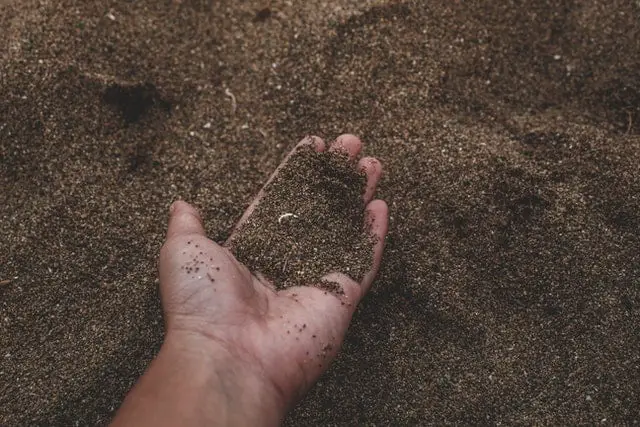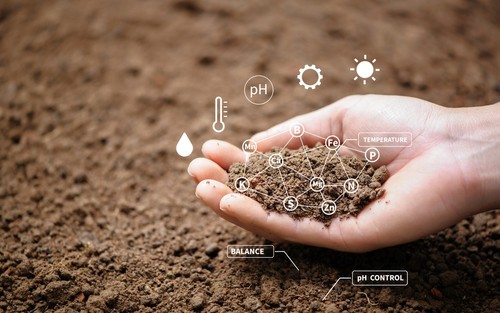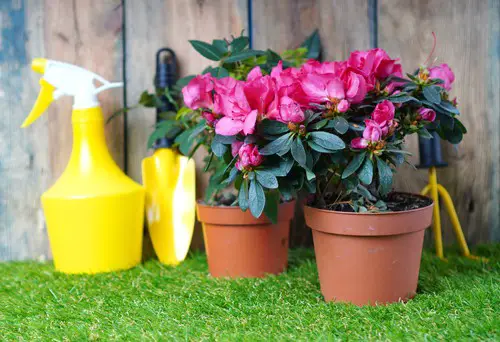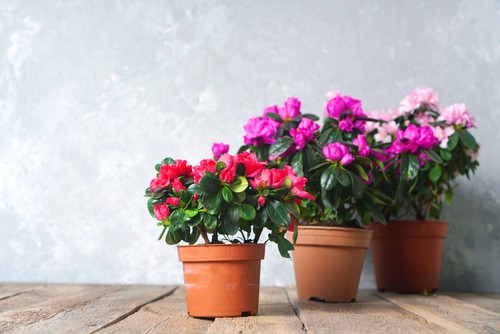Azaleas are a popular choice among gardeners for their vibrant blooms and easy maintenance. However, azalea leaves turning yellow and brown leaves can be a common issue that can affect the overall health and beauty of the plant. Understanding the causes of leaf discoloration and how to fix it can help ensure that your azaleas remain healthy and vibrant.
There are several common causes of azalea leaves turning yellow and brown. Lack of water, too much sun exposure, nutrient deficiency, and pests are some of the most common culprits. Identifying the cause of the issue is the first step in fixing it.
Depending on the cause, the solution may range from simply adjusting watering habits to applying pesticides or fertilizers. By taking the necessary steps, you can help your azaleas thrive and maintain their beauty.
Key Takeaways
- Identifying the cause of yellow and brown leaves is crucial in fixing the issue.
- The causes of leaf discoloration can range from lack of water to pests and nutrient deficiency.
- Proper care and maintenance can help prevent yellow and brown leaves in azaleas.
Also see:
Understanding Azalea Leaves Turning Yellow and Brown

Azalea is a beautiful flowering plant that is popular for its vibrant colors and easy maintenance. However, one common problem that azalea owners face is the discoloration of the leaves, turning yellow and brown. This can be caused by various factors, including environmental stress, nutrient deficiencies, and diseases.
Yellowing of azalea leaves is a common sign of stress. It can occur due to overwatering, underwatering, or exposure to extreme temperatures. Inadequate drainage can also cause yellowing of the leaves, as it leads to root damage and poor nutrient uptake.
Similarly, too much direct sunlight can cause the leaves to turn yellow and brown, as it damages the chlorophyll pigments responsible for photosynthesis.
Nutrient deficiencies are another common cause of azalea leaves turning yellow and brown. Azaleas require acidic soil with a pH between 4-6, and nutrient-rich soil to thrive. Lack of nitrogen, iron, or magnesium can cause yellowing of the leaves, while brown discoloration can be a sign of potassium or calcium deficiencies.
Soil testing can help identify the specific nutrient deficiency and guide appropriate soil amendments.
Diseases can also cause yellowing and browning of azalea leaves. Phytophthora root rot is a common fungal disease that affects azaleas, causing yellowing and wilting of the leaves. Similarly, lace bugs and spider mites can cause yellowing of the leaves, as they suck the sap out of the plant, leading to poor nutrient uptake.
Azalea Leaves Turning Yellow and Brown – 5 Common Problems
Azaleas are a popular ornamental plant, known for their vibrant blooms and glossy green leaves. However, yellow or brown leaves can be a sign of stress or disease. Here are some common causes of leaf discoloration in azaleas:
1. Watering Issues
Overwatering or underwatering can cause yellow or brown leaves in azaleas. When the soil is too wet, the roots can suffocate and become damaged, leading to yellow leaves. On the other hand, when the soil is too dry, the leaves can wilt and turn brown. It is important to water azaleas consistently, ensuring that the soil is moist but not waterlogged.
2. Soil Conditions

The pH level of the soil can also affect the health of azalea leaves. Azaleas prefer acidic soil with a pH between 4 and 6. If the soil is too alkaline, the leaves can turn yellow. Soil that doesn’t drain well can also cause root rot and yellow leaves. It is important to ensure that the soil is well-draining and has the correct pH level for azaleas.
3. Sun Exposure
Azaleas prefer partial shade and can become stressed if they are exposed to too much sunlight. Leaves can turn yellow or brown if they are exposed to direct sunlight for prolonged periods. It is important to plant azaleas in a location that receives partial shade or to provide shade during the hottest parts of the day.
4. Pest Infestations
Lace bug infestations are a common cause of yellowing leaves in azaleas. These small insects feed on the leaves, causing yellow or white spots to appear. Other pests, such as mites and aphids, can also cause yellow or brown leaves. It is important to inspect azaleas regularly for signs of pest infestations and to treat them promptly.
5. Disease and Fungal Infections
Fungal diseases such as Botryosphaeria can cause yellow or brown leaves in azaleas. These diseases can be caused by overwatering, poor soil drainage, or other environmental factors. It is important to ensure that azaleas are planted in well-draining soil and to avoid overwatering them.
How to Fix Yellow and Brown Leaves
When azalea leaves start turning yellow or brown, it is a sign that something is not right. However, there are several steps that can be taken to fix the issue and restore the plant’s health.
1. Check the Watering Schedule
One of the most common reasons for yellow or brown leaves is improper watering. Azaleas need consistent moisture, but they should not be overwatered. The soil should be kept moist, but not waterlogged. It is important to check the watering schedule and adjust it as needed.
2. Soil Test

A soil test can help determine if the soil has the right balance of nutrients. Azaleas prefer acidic soil with a pH between 4.5 and 6.0. If the soil is too alkaline, the plant may not be able to absorb nutrients properly, leading to yellow or brown leaves. A soil test can help identify any deficiencies and determine the best course of action.
3. Fertilizer
Fertilizer can help provide the necessary nutrients for healthy growth. However, too much fertilizer can lead to fertilizer burn, which can cause yellow or brown leaves. It is important to follow the recommended application rate and schedule for the specific type of fertilizer being used.
4. Compost
Compost can help improve soil quality and provide nutrients for the plant. It is important to use compost that has been properly decomposed and does not contain any weed seeds.
5. Mulch
Mulch can help retain moisture in the soil and regulate soil temperature. However, if the mulch is applied too thickly, it can lead to fertilizer burn and cause yellow or brown leaves. It is important to apply mulch in a thin layer and keep it away from the base of the plant.
Overall, fixing yellow and brown leaves on azaleas requires identifying the underlying issue and taking the appropriate steps to address it. A combination of proper watering, soil testing, fertilizer, compost, and mulch can help restore the plant’s health and prevent further damage.
Preventing Yellow and Brown Leaves in Azaleas
Azaleas are beautiful shrubs that are known for their vibrant and colorful blooms. However, yellow and brown leaves can be a common issue that gardeners face when growing azaleas. Fortunately, there are several measures that can be taken to prevent this problem from occurring.
Proper Planting and Care

Proper planting techniques and care are essential to maintaining healthy azaleas. When planting azaleas, it is important to choose a location that provides partial shade and protection from the wind.
Azaleas prefer well-drained soil that is slightly acidic, with a pH between 4.5 and 6.0. Gardeners should also ensure that the soil is not waterlogged, as this can lead to root rot and yellowing leaves.
Once planted, azaleas should be watered regularly, providing approximately one inch of water per week. However, it is important to note that overwatering can also lead to yellowing leaves. If the soil feels moist to the touch, it is best to stop watering until the soil dries out.
Pruning and Maintenance
Proper pruning and maintenance can also help prevent yellow and brown leaves in azaleas. Dead or diseased branches should be removed promptly, as they can cause stress to the plant and lead to yellowing leaves. Additionally, azaleas should be pruned after they have finished blooming to encourage healthy growth.
Fertilizing azaleas can also help prevent yellow and brown leaves. However, it is important to avoid excessive fertilization, as this can lead to burning of the leaves and other issues. Gardeners should follow the manufacturer’s instructions when fertilizing azaleas.
Optimal Environment
Finally, creating an optimal environment for azaleas can help prevent yellow and brown leaves. Azaleas prefer partial shade and protection from the wind, as excessive sun exposure and wind can cause stress to the plant. If an azalea is receiving too much sun, it may be necessary to transplant it to a location with more shade.
Azalea Varieties and Their Characteristics

Azaleas are a popular flowering shrub that come in a variety of colors, including white, red, pink, and black. They are closely related to rhododendrons and are often grouped together in garden centers and nurseries. Azaleas are further classified into two categories: evergreen and deciduous.
Evergreen azaleas retain their leaves year-round and are often used as foundation plants or in borders. They typically bloom in the spring and are available in a wide range of colors. Some popular evergreen azalea varieties include:
- ‘Girard’s Fuchsia’: A compact shrub with dark green leaves and large, fuchsia-colored flowers.
- ‘Hino Crimson’: A low-growing shrub with dark green leaves and bright red flowers.
- ‘Stewartstonian’: A medium-sized shrub with dark green leaves and deep red flowers.
Deciduous azaleas lose their leaves in the fall and are often used as specimen plants or in woodland gardens. They typically bloom in the summer and are available in fewer colors than evergreen azaleas. Some popular deciduous azalea varieties include:
- ‘Golden Lights’: A tall shrub with yellow flowers that bloom in early summer.
- ‘Mandarin Lights’: A medium-sized shrub with orange flowers that bloom in late spring.
- ‘Rosy Lights’: A tall shrub with pink flowers that bloom in mid-spring.
In addition to their color and growth habit, azaleas also vary in their soil and light requirements. Some azaleas prefer acidic soil, while others can tolerate a wider pH range. Similarly, some azaleas prefer full sun, while others prefer partial shade. It is important to select an azalea variety that is well-suited to the growing conditions in your area to ensure success.
Frequently Asked Questions
What causes azalea leaves to turn yellow and brown?
Azalea leaves can turn yellow and brown due to several reasons, including lack of water, nutrient deficiency, disease, insect infestation, and environmental stressors such as extreme temperatures and wind damage.
How can I prevent azalea leaves from turning yellow and brown?
To prevent azalea leaves from turning yellow and brown, it is essential to provide them with adequate water, nutrients, and proper care. Plant azaleas in well-draining soil and keep the soil moist but not waterlogged.
Fertilize them with a specialized fertilizer for acid-loving plants in the spring or early summer. Prune them regularly to remove dead or damaged branches and promote healthy growth.
What are the best treatments for azalea leaves that are turning yellow and brown?
The best treatments for azalea leaves that are turning yellow and brown depend on the underlying cause of the problem. If the leaves are turning yellow due to a lack of nutrients, fertilize the plants with a balanced fertilizer.
If the leaves are turning brown due to disease or insect infestation, treat them with a fungicide or insecticide, respectively. If the leaves are turning yellow and brown due to environmental stressors, provide them with proper care and protection.
Are yellow and brown leaves on azaleas a sign of disease or nutrient deficiency?
Yellow and brown leaves on azaleas can be a sign of disease or nutrient deficiency, but they can also be a sign of environmental stressors or insect infestation. It is essential to identify the underlying cause of the problem before treating the plants.
When is the best time to prune azaleas with yellow and brown leaves?
The best time to prune azaleas with yellow and brown leaves is after they have finished blooming in the spring. Prune them to remove dead or damaged branches and promote healthy growth.
Can I save my azalea if the leaves are turning yellow and brown?
Yes, you can save your azalea if the leaves are turning yellow and brown by identifying the underlying cause of the problem and providing them with proper care and treatment. If the problem is due to lack of water or nutrients, provide them with adequate water and fertilize them with a specialized fertilizer for acid-loving plants.
If the problem is due to disease or insect infestation, treat them with a fungicide or insecticide, respectively. If the problem is due to environmental stressors, provide them with proper care and protection.

Hey, I’m Lisa and I’ve been an avid gardener for over 30 years. I love writing, talking and living in the garden! Feel free to connect with me on my socials below

